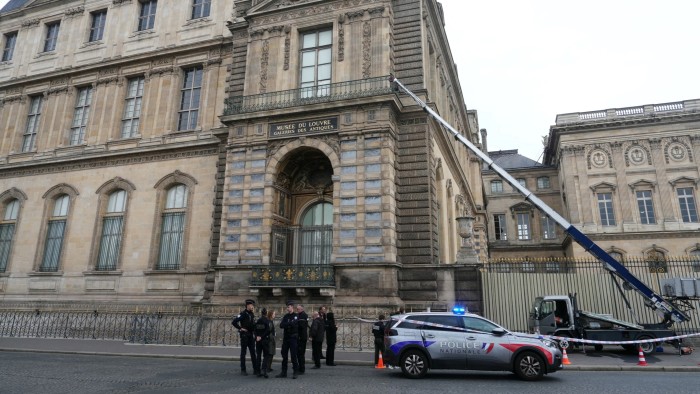Unlock the Editor’s Digest for free
Roula Khalaf, Editor of the FT, selects her favourite stories in this weekly newsletter.
Thieves have stolen royal jewellery of “inestimable” historical value from Paris’s Louvre museum, the French interior ministry said, in a heist that shuttered one of the world’s most famous attractions for the day.
The robbers stole from the museum’s Galerie d’Apollon, which houses its royal jewel collections, on Sunday morning, according to the ministry. The value of the seized items is still being ascertained.
French President Emmanuel Macron said late on Sunday that “the theft committed at the Louvre is an attack on a heritage that we cherish because it is our history.
“We will recover the works, and the perpetrators will be brought to justice. Everything is being done, everywhere, to achieve this, under the leadership of the Paris prosecutor’s office,” he added.
Culture minister Rachida Dati said on X that no one was injured in the incident, and police were on the scene investigating the break-in.
“They acted professionally, without any violence or panic,” Dati told TF1 later on Sunday.
The interior ministry said the thieves arrived on scooters and entered through a window they had broken. According to the AFP news agency, they had small chainsaws and used a goods lift to enter the room at about 9.30am.
Le Parisien reported that the thieves secured “nine pieces from the jewellery collection of Napoleon” and his empress. The newspaper said later on Sunday that two of the artefacts had been retrieved, including the crown of Empress Eugénie, which was found broken outside the museum. Dati confirmed one piece had been found and said it was being evaluated.
The Financial Times could not immediately confirm the number or nature of the stolen pieces.
“These are professionals, museums have become targets,” Dati said adding that upgrading security at these institutions was “an old issue”.
“For 40 years, no one has paid attention to securing these major museums,” she said. “These museums need to adapt to new forms of crime. It has become organised crime.”
The museum said on X that it would remain closed for the day “for exceptional reasons”.
The Louvre, which houses thousands of treasures including Da Vinci’s “Mona Lisa” has been targeted before, notably in 1911 when the famous painting was stolen by a handyman. It was recovered and returned two years later.
Most of the museum’s art and artefacts were also hidden away by staff during the second world war Nazi occupation of France in a bid to prevent looting and damage from bombings.
Confirmed thefts from within the highly secure museum are rare, however. The last such incident from inside the museum complex was in 1998, according to Smithsonian magazine, when a small landscape painting was stolen.
President Macron earlier this year announced a €800mn makeover plan for the Louvre, which included increasing the “safety and security of the collections”, as well as upgrading the museum’s surveillance and IT systems. The Élysée said the president had been informed of the thefts.
Read the full article here
